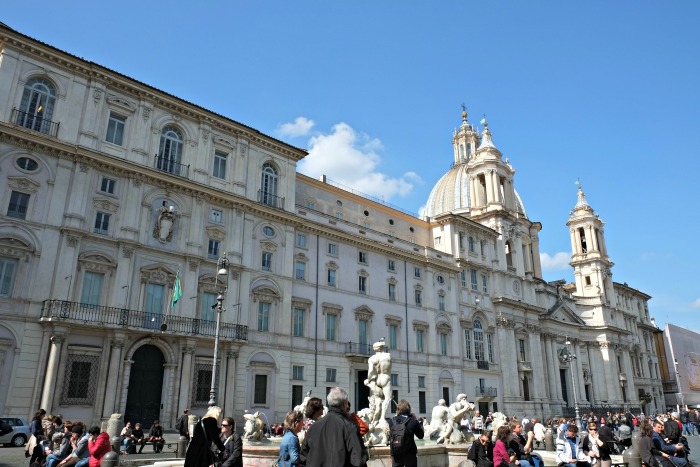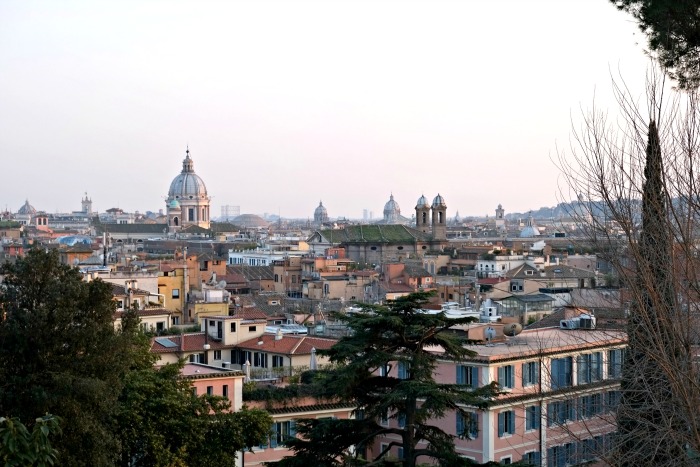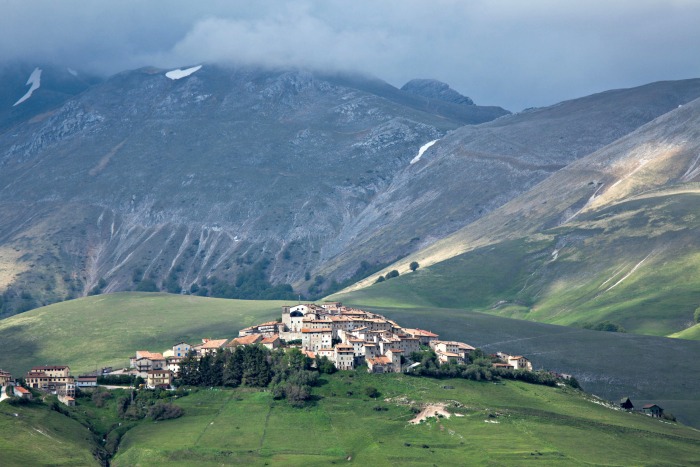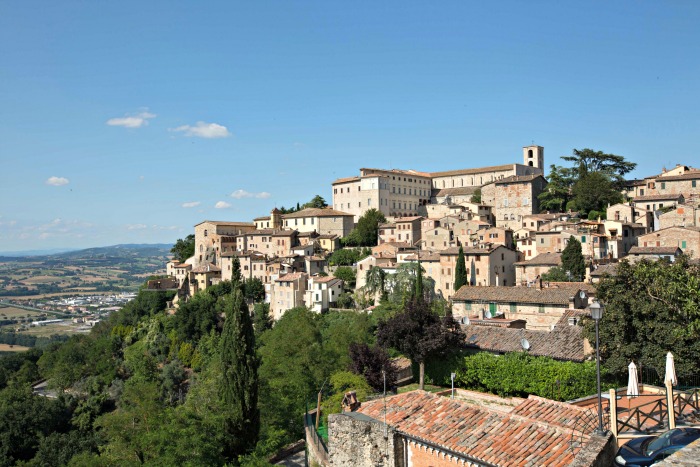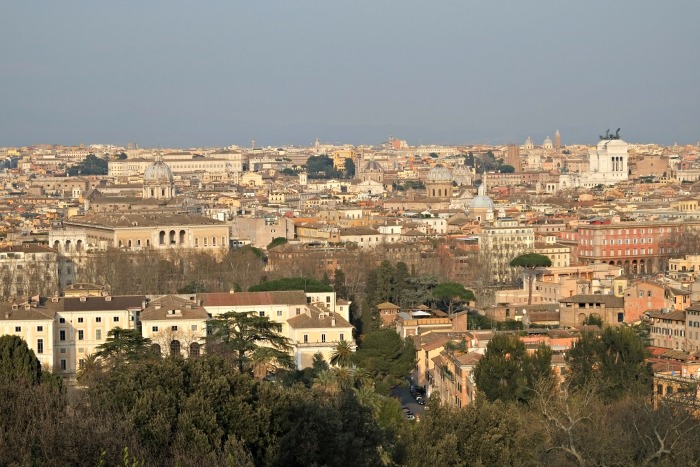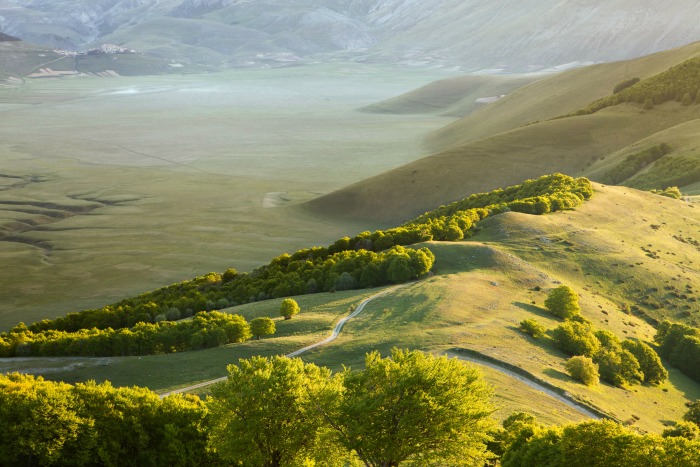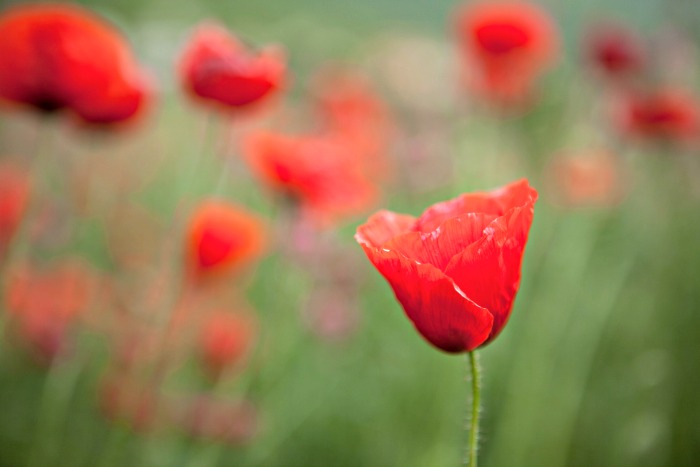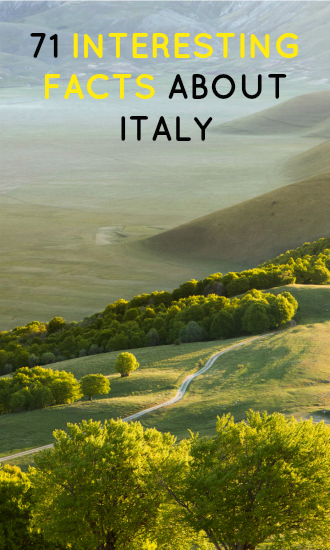I always try to learn some facts about the countries I visit, and so I started this series of fact posts. I’ve gathered facts about Belgium, facts about Germany, facts about Greece and now it’s time for some fast facts about Italy.
75 fast facts about Italy
This post is part of a series of fun facts posts I’m doing for every country I have articles about here on the blog. Given their nature, these posts are research-based and even though a lot of time has gone into them, it’s still possible a mistake has snuck in. If you see something that looks incorrect, please let me know at wanderer [at] wonderfulwanderings.com and I’ll look into it. Thanks!
1. Rome, the capital of Italy, is called the “Eternal City” because the ancient Romans believed that Rome will remain forever. In Virgil’s Aeneid, Jupiter’s promise to his daughter Venus when she asked about the future of her son’s descendants was: “I give them empire without end”.
2. Maybe not one of the most fun facts about Italy but important nonetheless, is that the tricolor flag design of the Italian flag was inspired by France when Napoleon’s army took over Northern Italy.
3. The Colosseum is officially called the “Flavian Amphitheater” because it was built during the Flavian dynasty under Emperor Vespasian’s rule, and it finally opened during the reign of his son Titus. The enormous arena was used for gladiator and wild animal fights, as well as public executions for four centuries until it was neglected and damaged by an earthquake in 1231 CE. Read about my visit to the Colosseum here.
4. Formerly a grassy wetland and burial ground, the Forum Romanum became the Roman empire’s economic and political center where government offices, tribunals, religious monuments, memorials and statues were built.
5. Ancient Rome’s most preserved structure is the Pantheon, a popular attraction showcasing classical Roman architecture. It is believed to have been built as a temple dedicated to the gods.
6. The present St. Peter’s Basilica isn’t the original one. The first church was built by Emperor Constantine at the site where St. Peter was supposedly buried. It was in an unrepairable state by the early Renaissance period so it was demolished and a new one was built.
7. More than a hundred tombs could be found in the grottoes or necropolis of St. Peter’s Basilica. Ninety-one popes, the Holy Roman Emperor Otto II and Swedish Queen Christina are among those buried there.
8. Michelangelo’s the Pietà in St. Peter’s Basilica was encased in bulletproof glass after a mentally disturbed geologist, Laszlo Toth, attacked the sculpture with a hammer in 1972.
9. The Basilica di San Giovanni in Laterano (Basilica of St. John Lateran) is Rome’s cathedral (not St. Peter’s Basilica), and the oldest among the four major basilicas in Rome. It is also the Roman Catholic “Mother Church” and the official ecclesiastical seat of the Bishop of Rome—the Pope.
10. Michelangelo was reluctant to accept the commission to paint the ceiling of Sistine Chapel since he was working on Pope Julius II’s marble tomb at that time. He also considered himself a sculptor rather than a painter.
11. The largest and most famous Baroque fountain in Rome is the Trevi Fountain. Legend says that if you throw a coin into the fountain, it will guarantee your return to Rome.
12. The world record truffle weighing 3.3 pounds was discovered in Tuscany by a dog named Rocco and it was sold at an auction to Macau casino mogul and billionaire Stanley Ho for $330,000.
13. Perugia, in Umbria, may not be the first place you think of when the subject of chocolate comes up, but its reputation is global. In fact, it is so famous that it is the official home of the Eurochocolate Festival. This week-long street festival celebrates all things chocolate and draws visitors from all over the world.
14. Italian journalist and author Carlo Lorenzini wrote the novel The Adventures of Pinnochio. His pseudonym “Carlo Collodi” was taken from his mother’s hometown Collodi in Tuscany where the Pinocchio Park opened in 1956.
15. The opening of the first McDonald’s in Rome in 1986 caused a frenzy among eager teenagers but on the contrary, famous Italian fashion designer, Valentino, sued the restaurant because of “significant and constant noise and an unbearable smell of fried food fouling the air”. The opening also faced a protest organized by the “Save Rome” committee comprised of singers, actors and politicians who opposed fast food and the “Americanization” of Italian culture. Supporters were served plates of spaghetti to signify their stand to preserve the “Land of Pasta”. You can read more about the McDonald’s protest on the NY Times.
16. The United States banned Prosciutto from being imported until 1989, and Mortadella and Speck until 2000. Other meats like Cotechino and Zampone are still banned at present. Some say it is to protect the American livestock from disease but most speculate that it is to protect US meat producers from competition.
17. Authentic Italian mozzarella is made from the water buffalo’s milk which makes it sweeter and creamier due to its higher fat content. It should also be served while fresh to keep it naturally moist instead of being refrigerated, which makes it dry and rubbery.
18. Pasta was introduced to Italy when the Arabs invaded Sicily in the 8th century. You can make your own pasta on a food tour in Bologna, for example.
19. Meatballs and spaghetti combined is not an Italian thing. Italian meals are normally served in two parts: primo piatto (pasta and risotto) and secondo piatto (any meat and fish dish complemented by a contorno, as side serving of vegetables).
20. The Alfredo pasta is also not Italian; it is an American dish.
21. The Italian Wedding Soup or Minestra Maritata is not traditionally served at Italian weddings. “Maritata” means “married” but in the context of the dish, it pertains to the soup’s ingredients — meats and green vegetables — going well together, therefore “married” in a sense.
22. At the time of writing, there is not a single Starbucks store in Italy. The beginnings of the coffee shop giant were actually influenced by Howard Schultz’s (Chairman & CEO) trip to Milan. In March 2016, it was announced that the first Starbucks Italy will open in Milan in 2017.
23. Another fun fact about Italy is that Pizza gained popularity in Italy among peasants during the 16th century when tomatoes were introduced from Peru.
24. Pizza Margherita is believed to have been named after Queen Margherita of Savoy when she visited Pizzeria Brandi in Naples in 1889.
25. The Friuli region of Italy has benefitted from changing borders and cultural differences over the centuries. Italian, Austrian, Slovenian, and Croatian influences have affected many aspects of life in this region, but none more than the variety of food. Although Friuli’s prosciutto is one of its most famous exports, the cultural mash-ups of food make for amazing dining experiences.
26. The biggest university in Europe and the oldest in Rome is the Sapienza University of Rome founded by Pope Boniface VIII in 1303.
27. The symbol SPQR inscribed on buildings, coins and park benches in Rome stands for Senatus Populus Que Romanus (“the Senate and the People of Rome”) signifying that they are now part of the Roman Republic, and not ruled by kings.
28. The Vatican City or the Holy See is an independent city-state governed by an absolute monarchy (the Pope) and has its own flag, anthem, army (Swiss Guard), money, stamps, pharmacy, post office, telephone system, money and media outlets. It is about one-eighth the size of New York’s Central Park with an estimated population of over 800 residents. Hence, it is considered the “smallest country in the world”.
29. Monte Bianco (“White Mountain”) is the highest mountain peak in the Alps and in Western Europe towering approximately 15,780 feet.
30. Ferrari, Lamborghini, Maserati, and Alfa Romeo are the most popular Italian sports car brands worldwide. You can visit the Maserati and the Ferrari Museum in Modena, the Lamborghini Museum in Sant’ Agata Bolognese, and the Alfa Romeo Museum in Milan.
31. Italy’s national literary classic I Promessi Sposi (“The Betrothed”) by Alessandro Manzoni is considered the 19th-century Italian counterpart of Shakespeare’s Romeo and Juliet.
32. The opera had its beginnings in Florence at the end of the 16th century in the form of intermezzi—intermediate, lavish musical pieces performed between acts of plays. The earliest known opera is Jacopo Peri’s Dafne.
33. The first working model of the telephone was actually made by the Italian Innocenzo Manzetti in 1865 but was not patented. Italian immigrant Antonio Meucci was the first to patent the invention but when he was unable to afford the patent renewal, Alexander Graham Bell bought the patent in 1876 and that’s why the invention of the telephone is credited to him.
34. The first battery — a “voltaic pile” of copper and zinc plates separated by paper discs soaked in brine — was invented by Alessandro Volta in 1799.
35. The eyeglasses were invented sometime in the last quarter of the 13th century in the Veneto region.
36. Renowned Italian astronomer, physicist, mathematician, inventor and philosopher Galileo Galilei got in trouble with the church for supporting and promoting Nicolaus Copernicus’ theory that the earth orbited the sun. He was sentenced to life imprisonment, which was eventually reduced to house arrest where he spent the final years of his life. The Vatican cleared him of heresy only in 1992 — more than 300 years after his death.
37. A fan of Galileo’s apparently cut off the middle finger from his right hand as a keepsake when his body was moved for reburial 100 years since he died. It is now displayed as a relic at the Museo Galileo in Florence.
38. Leonardo da Vinci, famous for the Mona Lisa, The Last Supper and his many contributions to the arts and sciences, had no formal education apart from learning basic reading, writing, and math. Recognizing da Vinci’s artistic talent, his father made him an apprentice to sculptor and painter Andrea del Verrochio.
39. Galileo’s student, Evangelista Torricelli, invented the mercury barometer, a device that measures air pressure.
40. Nobel Prize winner Guglielmo Marconi from Bologna invented the radio.
41. Featuring a magnificent castle as well as a famous cathedral, Gorizia is actually only half of what it once was. In 1945 the city was divided into the towns of Gorizia on the Italian side, and Nova Gorica, on the Slovenian side. Once the most important town in the region, Gorizia lost much of its importance following the split.
42. The invention of the jacuzzi is credited to the Italian Jacuzzi family who migrated to the United States. It started from a hydrotherapy pump used as a treatment for one brother who had juvenile rheumatoid arthritis. Two generations after, the first hot tub was built by Roy Jacuzzi.
43. Bartolomeo Cristofori from Padua is said to have invented the piano which was called gravicembalo col piano e forte (“harpsichord that plays soft and loud”) back then.
44. The MPEG and MP3 were created by Leonardo Chiariglione and his team.
45. Founded in Siena in 1472, Banca Monte dei Paschi di Siena, is known as the world’s oldest bank.
46. In 1884, Angelo Moriondo made a patent for a “new steam machinery for the economic and instantaneous confection of coffee beverage” which led to the invention of the espresso machine by Luigi Bezzera and Desiderio Pavoni who improved on Moriondo’s original design.
47. The prototype of the nuclear reactor was developed by Nobel-Prized physicist Enrico Fermi. He became among those who led the Manhattan Project aimed to develop the first atomic bomb.
48. The modern liposuction procedure evolved from the blunt tunneling technique invented by father and son gynecologists Arpad and Giorgio Fischer from Rome.
49. Genoese-born Cristoforo Colombo, more known as Christopher Columbus, made the American continents known to Europe through his voyage commissioned by Spanish King Ferdinand and Queen Isabella, which original mission was to explore Asia and bring back spices from China.
50. Venetian merchant Marco Polo introduced China and Central Asia to Europe through his travels around the world for 24 years together with his father and uncle.
51. Italian Giovanni Caboto, more known as John Cabot, established the first British overseas colony — a fishing settlement — in Newfoundland through an exploration commissioned by Henry VII of England.
52. Giovanni Maria Farina, born and raised in Italy but moved to Cologne in Germany, created the first fragrant water to remind him of the scent of Italy on a spring morning. It is now known as “Eau de Cologne”.
53. The only active volcano on mainland Europe, Mount Vesuvius is one of the most dangerous volcanoes in the world. Its catastrophic eruption in A.D. 79 buried the city of Pompeii and killed nearly 16,000 people.
54. Italy’s former currency was the lira before it adopted the euro.
55. The country with the most UNESCO World Heritage Sites is Italy with 51.
56. Torre Pendente di Pisa (“the Leaning Tower of Pisa”) weighing approximately 14,500 tons has eight stories including a chamber for seven bells each representing a note of the major scale. It stopped moving in 2008 and engineers expect that it will remain stable for two more centuries.
57. The mafia originated in post-feudal Sicily when groups emerged as “mafies” or private armies in the 19th century who extorted protection money from landowners.
58. Top fashion designer Gianni Versace designed for celebrities including Madonna, Princess Diana, Elton John, Elizabeth Hurley, Naomi Campbell and Tina Turner, and built a fashion empire worth over $800 million in less than a decade. He was shot and killed outside his home in Florida in 1997. His sister, Donatella Versace, became the creative director of the Versace Group after his death.
59. Giorgio Armani got his first taste in fashion while he was on vacation in Milan and got a job at a department store to assist a photographer. He dropped out of medical school after finishing his military service and joined Nino Cerruti as a designer, and the rest is history. He has been in the industry for more than three decades and has achieved great success.
60. Born in Lombardy, Valentino Garavani apprenticed under local designers at a young age. He became famous for his “Valentino red” dresses and was the favorite designer of Jacqueline Kennedy.
61. Another Italy fun fact is that Miucca Prada from Milan inherited her family’s business in 1978 with no formal fashion training. She earned a Ph. D. in political science and was a former member of the Italian Communist Party. Together with her husband, Patrizio Bertelli, they grew the business and it’s now known as one of the most famous fashion brands.
62. The Chairman of the Benetton Group, Luciano Benetton, was an Italian Senator from 1992 to 1994.
63. The House of Gucci started as a small family-owned leather saddlery shop in 1905. From selling leather bags to horsemen, Guccio Gucci expanded his business and opened a store in Milan. After his death, his sons and grandsons continued running and expanding the business until it grew to be one of the most prominent fashion brands worldwide.
64. The origins of Italian surnames are either patronymic, occupational, descriptive or geographical. Surnames ending in “o” usually come from Southern Italy, while surnames ending with “i” are often from Northern Italy.
65. Know, variously as The Queen of the Adriatic, City of Water, City of Masks, City of Canals, and The Floating City, Venice is comprised of a number of small islands in the Grand Canal. One of its most famous attractions is the Palazzo Ducale. Once the headquarters of the Republic of Venice and the living quarters of its leader, the Duke of Venice, it is now an enormous museum housing many historical artifacts. Not widely advertised, visitors can book what is called The Secret Itineraries Tour. This includes access to prisons, torture chambers, and The Bridge of Sighs.
66. Another interesting fact about Italy is that The Sardinian islands are known for their “witches” who concoct health potions for the locals.
67. Bocce is an Italian sport similar to lawn bowling, but the goal is for one of your team’s assigned balls to be closer than any of your opponent’s balls to the “boccino” or “pallino” (small target ball).
68. Italian conversation wouldn’t be complete without hand gestures.
69. AC Milan 1988-1990 is considered one of the greatest soccer teams of all time.
70. The number 13 is considered a lucky number in Italy. The expression “fare tredici” (to do 13) means ‘to hit the jackpot’. On the other hand, 17 is an unlucky number.
71. Sophia Loren, known as the ‘Italian Marilyn Monroe’, was born in Rome.
72. Italian actor, director, and producer Roberto Benigni is best known for his 1997 Oscar-Winning Film La Vita e Bella (Life is Beautiful).
73. Renowned Baroque composer Antonio Vivaldi was ordained as a priest but instead chose to pursue his passion for music.
74. As a guest in Italy, observe the “fare i complimenti” rule — don’t accept food when it’s offered the first time; only accept when you’ve been asked twice.
75. It’s considered taboo to mention or talk about ‘sex’ in a family conversation in Italy. Politics, the mafia and the Vatican are other topics to be avoided in conversations to prevent fights or someone getting offended.
And that was it for these fun and important facts about Italy! Do you know any others?
Pin for later

